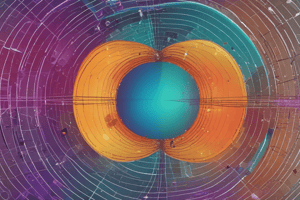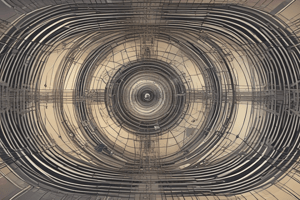Podcast
Questions and Answers
What is speed?
What is speed?
How fast something moves; the distance traveled per unit of time.
What is velocity?
What is velocity?
The speed of an object and a specification of its direction of motion.
What is a vector quantity?
What is a vector quantity?
Quantity in physics that has both magnitude and direction.
What is acceleration?
What is acceleration?
What is free fall?
What is free fall?
Speed = ______
Speed = ______
Average speed = ______
Average speed = ______
Acceleration = ______
Acceleration = ______
Acceleration (along a straight line) = ______
Acceleration (along a straight line) = ______
Velocity acquired in free fall, from rest; v = ______
Velocity acquired in free fall, from rest; v = ______
Distance fallen in free fall, from rest; d = ______
Distance fallen in free fall, from rest; d = ______
Motion is relative.
Motion is relative.
What is linear motion?
What is linear motion?
What is instantaneous speed?
What is instantaneous speed?
What is constant velocity?
What is constant velocity?
What happens when either speed or direction changes?
What happens when either speed or direction changes?
What is constant speed?
What is constant speed?
The two measurements necessary for calculating average speed are ______
The two measurements necessary for calculating average speed are ______
If a horse gallops a distance of 10 kilometers in a time of 30 minutes, what is its average speed?
If a horse gallops a distance of 10 kilometers in a time of 30 minutes, what is its average speed?
If a car maintains a constant velocity of 100 km/hr for 10 seconds, what is its acceleration?
If a car maintains a constant velocity of 100 km/hr for 10 seconds, what is its acceleration?
Twelve seconds after starting from rest, what will be the speed of an object falling freely?
Twelve seconds after starting from rest, what will be the speed of an object falling freely?
In each second of fall, the distance a freely falling object will fall is increasing.
In each second of fall, the distance a freely falling object will fall is increasing.
If you drop a rock from a 5-m height, how does its acceleration compare to being dropped from a height of 2.5 m?
If you drop a rock from a 5-m height, how does its acceleration compare to being dropped from a height of 2.5 m?
At one instant, if a heavy object in the air is moving upward at 50 meters per second, what is its speed one second later?
At one instant, if a heavy object in the air is moving upward at 50 meters per second, what is its speed one second later?
If a projectile is fired straight up at a speed of 10 m/s, how long does it take to reach the top of its path?
If a projectile is fired straight up at a speed of 10 m/s, how long does it take to reach the top of its path?
Acceleration is not velocity, nor is it even a change in velocity; it is [blank]
Acceleration is not velocity, nor is it even a change in velocity; it is [blank]
Flashcards are hidden until you start studying
Study Notes
Key Concepts in Linear Motion
- Speed: Defined as distance traveled per unit of time, indicating how fast an object moves.
- Velocity: Combines speed with a directional component, defining both how fast and in what direction an object moves.
- Vector Quantity: A physical quantity that possesses both magnitude (size) and direction, e.g., velocity and acceleration.
- Acceleration: Measures how quickly an object’s velocity changes, which can be due to a change in speed, direction, or both.
- Free Fall: Describes the motion of an object influenced only by gravity, without any other forces acting on it.
Equations and Calculations
- Speed Equation: Speed = Distance / Time.
- Average Speed Equation: Average Speed = Total Distance Covered / Time Interval.
- Acceleration Equation: Acceleration = Change of Velocity / Time Interval.
- Acceleration (along a straight line): A measure of the change in speed over time.
- Velocity in Free Fall: When falling from rest, velocity can be calculated using v = gt, where g is the acceleration due to gravity.
- Distance Fallen in Free Fall: Can be derived from d = ½ gt², representing how far the object falls over time.
Motion Characteristics
- Relative Motion: All motion is measured relative to a frame of reference.
- Linear Motion: Involves movement along a straight line.
- Instantaneous Speed: The speed of an object at any precise moment in time.
- Constant Velocity: Occurs when an object moves in a straight line at a uniform speed.
- Changing Velocity: Happens when there is a change in speed or direction (or both).
Average Speed and Examples
- Necessary Measurements: Average speed calculations require both distance and time.
- Example of Average Speed: A horse covering 10 km in 30 minutes has an average speed of 20 km/h.
- Acceleration Example: A car traveling at a constant velocity of 100 km/h for 10 seconds experiences zero acceleration.
Free Fall Dynamics
- Speed After 12 Seconds: An object in free fall from rest reaches speeds exceeding 100 m/s after 12 seconds.
- Increasing Fall Distance: Each second of free fall results in an increased distance fallen due to constant acceleration.
- Acceleration Consistency: Dropping a rock from heights of 5 m or 2.5 m shows that the acceleration due to gravity remains about the same.
Projectile Motion
- Upward Motion: A heavy object moving upward at 50 m/s will slow to about 40 m/s after 1 second due to gravity.
- Projectile Time to Top: For a projectile fired straight up at 10 m/s, reaching the peak takes approximately 1 second.
Understanding Acceleration
- Nature of Acceleration: It is defined as the rate at which an object's velocity changes over time, distinct from being merely a change in speed or velocity itself.
Studying That Suits You
Use AI to generate personalized quizzes and flashcards to suit your learning preferences.




